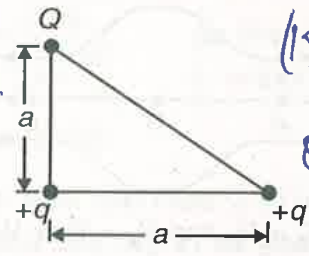Consider a system of three charges q3,q3 and –2q3 placed at points A, B and C, respectively, as shown in the figure. Take O to be the centre of the circle of radius R and angle CAB = 60∘ :-

The electric field at point O is q8πε0R2 directed along the neagtive x-axis
The potential energy of the system is zero
The magnitude of the force between the charges at C and B is q254πε0R2
The potential at point O is q12πε0R2
The correct Answer is:C
Electric field at point O is vector sum of electric field due to all three point charges individually .

→E.=→EA+→EB+→EC and →EA=−→EB
So →E.=→EC
=2q/34πε0R2 along →OC
=q6πε20R2 along →OC
=−q6πε0R2ˆi
From geometry , we can find that ∠ABC=30∘ and ∠ACB=90∘
So, AB=2R , AC=R , BC=√3R
Total potential energy of the system is,
U=14πε0[q/3×q/32R−q/3×2q/3R−q/3×2q/3√3R]≠0
F=q/3×2q/34πε0×(√3R)2
=q254πε0R2
Potential at point O is , V=q/3+q/3−2q/34πε0R=0
Topper's Solved these Questions
Similar Questions
Consider a system of three charges q3,q3and−2q3 placed ar point A,B and C respectively, as shown in the figure. Take O to be the centre of the circle of radius R and angle CAB=60∘. Choose the incorrect options

(1) The electric field at point O is q8πε0R2 directed along the negative x-axis
(2) The potential energy of the system is zero
(3) The potential at point O is q12πε0R
(4) The magnitude of the force between the charges at C and B is q254πε0R2
View SolutionConisder a system of three charges q/3, q/3 and −2q/3 placed at point A, B and C, respectively, as shown in the figure. Take O to be centre of the circle of radius R and angle CAB=60∘

View Solution
Knowledge Check
Conisder a system of three charges q/3, q/3 and −2q/3 placed at point A, B and C, respectively, as shown in the figure. Take O to be centre of the circle of radius R and angle CAB=60∘
 A(a) The electric field at point O is q8πε0R2 directed along the negative x-axis.B(b) The potential energy of the system is zeroC(c) The magnitude of the force between the charges at C and B is q254πε0R2D(d) the potential at point O is q12πε0R
A(a) The electric field at point O is q8πε0R2 directed along the negative x-axis.B(b) The potential energy of the system is zeroC(c) The magnitude of the force between the charges at C and B is q254πε0R2D(d) the potential at point O is q12πε0RCharges q,2q,3q and 4q are placed at the corners A,B,C and D of a square as shown in the following figure. The directon of electric field at the centre of the square is along
 AABBCBCBDDAC
AABBCBCBDDACThree charges −q1, +q2 and −q3 are placed as shown in the figure. The x-component of the force on −q1 is proportional to
 A(a) q2b2−q3a2cosθB(b) q2b2+q3a2sinθC(c) q2b2+q3a2cosθD(d) q2b2−q3a2sinθ
A(a) q2b2−q3a2cosθB(b) q2b2+q3a2sinθC(c) q2b2+q3a2cosθD(d) q2b2−q3a2sinθ
Charges q,2q,3q and 4q are placed at the corners A,B,C and D of a square as shown in the following figure. The directon of electric field at the centre of the square is along

View SolutionCharges q,2q,3q and 4q are placed at the corners A,B,C and D of a square as shown in the following figure. The directon of electric field at the centre of the square is along

View SolutionThree charges +q , +q, and Q are placed at the comers of a right angled isosceles triangle as shown in the figure. If the net potential energy of the system is zero then value of Q is

View SolutionThree charges of (+2q),(−q) and (−q) are placed at the corners A,B and C of an equilateral triangle of side a as shown in the adjoining figure. Then the dipole moment of this combination is

View SolutionThree charges of (+2q),(−q) and (−q) are placed at the corners A,B and C of an equilateral triangle of side a as shown in the adjoining figure. Then the dipole moment of this combination is

View Solution
